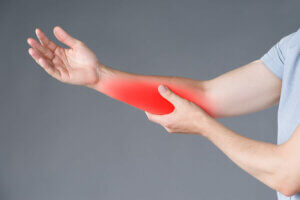Golfer's Elbow: Causes and Treatment

Some sports involve such specific movements that they can cause specific injuries. One example is golfer’s elbow, also known as medial epicondylitis, which is a condition that affects the tendons on the inside of the elbow. Let’s take a look at its causes and possible treatments.
Golfer’s elbow, what is it?
An epicondyle is a round protrusion on the condyle of a bone, and it can provide an attachment point for tendons and ligaments.
On the inside of the end of the humerus are two epicondyles: the lateral epicondyle and the medial epicondyle, both of which are on the inside of the elbow. This is where various tendons and ligaments in the arm are attached.
The suffix ‘-itis’ denotes inflammation, Therefore, epicondylitis is the name for inflammation of the epicondyle, and the word ‘medial’ indicates which epicondyle is affected.
Causes of golfer’s elbow
Now that you know what golfer’s elbow is, it’s easier to identify what causes it. The main cause is essentially tendonitis from overusing the tendons that attach to the epicondyle.

This can happen in four different ways:
- A repetitive movement that demands great strength from these muscles, such as a golf or tennis swing.
- Incorrect movements during sports. If you don’t consider your posture when doing sports, you have a greater risk of injuring muscles and tendons.
- Repetitive movements at work. Since the tendons that suffer are normally the ones that control the wrist and fingers, golfer’s elbow might also develop simply by working in front of the computer a lot.
- The excessive force being applied or exerted without an adequate warm-up.
So, as you can see, it’s mainly due to a build-up small-level wear and tear or one sudden injury which damages the tendons. The main place where you’ll feel pain will be where the tendon is attached to the bone, in this case, the medial epicondyle.
Treatment for golfer’s elbow
Tendinitis is difficult to heal in general, and golfer’s elbow is no exception. However, the probability of successful recovery increases considerably if you follow the following steps.
Rest
The first thing you need to do is let the tendons recover. This means not making the movements that caused the injury in the first place. The elbow has suffered structural damage and it needs to heal. You can’t expect this to happen without rest.
Anti-inflammatory measures
Secondly, you should take steps to reduce inflammation. Keep the arm elevated, apply cold or heat (depending on when the injury occurs) several times a day, and compress the area.
Similarly, you can also use anti-inflammatories. However, if you notice improvements without them, it’s always best to avoid them if you can.
Physiotherapy
Physiotherapy is a great way of combatting any type of tendinitis, and eccentric exercises in certain stages of recovery have been shown to be very beneficial.
Your physiotherapist can also advise you on exercises that you should do or avoid, as well as recommending stretches for the affected muscles. There will also be other techniques to relax the muscles and the use of neuromuscular bandages.

Precautionary measures
In addition to all of the above, it’s also important to learn how to avoid injury in the first place. If the injury is caused by work, you’ll have to take steps to prevent this from happening in the future.
Another option is to strengthen the affected muscles so that they can withstand the load in the long term. If possible, learn to also work with the other hand or arm and be able to change.
On the other hand, if the injury has been caused by sport, it’s important to understand if you’re doing it correctly. Then, you should consider whether your equipment or clothing is appropriate.
Neither can we forget the importance of planning your training sessions and giving yourself enough rest. Lastly, adapt your workload to your abilities and increase it gradually to give your body time to adjust.
Some sports involve such specific movements that they can cause specific injuries. One example is golfer’s elbow, also known as medial epicondylitis, which is a condition that affects the tendons on the inside of the elbow. Let’s take a look at its causes and possible treatments.
Golfer’s elbow, what is it?
An epicondyle is a round protrusion on the condyle of a bone, and it can provide an attachment point for tendons and ligaments.
On the inside of the end of the humerus are two epicondyles: the lateral epicondyle and the medial epicondyle, both of which are on the inside of the elbow. This is where various tendons and ligaments in the arm are attached.
The suffix ‘-itis’ denotes inflammation, Therefore, epicondylitis is the name for inflammation of the epicondyle, and the word ‘medial’ indicates which epicondyle is affected.
Causes of golfer’s elbow
Now that you know what golfer’s elbow is, it’s easier to identify what causes it. The main cause is essentially tendonitis from overusing the tendons that attach to the epicondyle.

This can happen in four different ways:
- A repetitive movement that demands great strength from these muscles, such as a golf or tennis swing.
- Incorrect movements during sports. If you don’t consider your posture when doing sports, you have a greater risk of injuring muscles and tendons.
- Repetitive movements at work. Since the tendons that suffer are normally the ones that control the wrist and fingers, golfer’s elbow might also develop simply by working in front of the computer a lot.
- The excessive force being applied or exerted without an adequate warm-up.
So, as you can see, it’s mainly due to a build-up small-level wear and tear or one sudden injury which damages the tendons. The main place where you’ll feel pain will be where the tendon is attached to the bone, in this case, the medial epicondyle.
Treatment for golfer’s elbow
Tendinitis is difficult to heal in general, and golfer’s elbow is no exception. However, the probability of successful recovery increases considerably if you follow the following steps.
Rest
The first thing you need to do is let the tendons recover. This means not making the movements that caused the injury in the first place. The elbow has suffered structural damage and it needs to heal. You can’t expect this to happen without rest.
Anti-inflammatory measures
Secondly, you should take steps to reduce inflammation. Keep the arm elevated, apply cold or heat (depending on when the injury occurs) several times a day, and compress the area.
Similarly, you can also use anti-inflammatories. However, if you notice improvements without them, it’s always best to avoid them if you can.
Physiotherapy
Physiotherapy is a great way of combatting any type of tendinitis, and eccentric exercises in certain stages of recovery have been shown to be very beneficial.
Your physiotherapist can also advise you on exercises that you should do or avoid, as well as recommending stretches for the affected muscles. There will also be other techniques to relax the muscles and the use of neuromuscular bandages.

Precautionary measures
In addition to all of the above, it’s also important to learn how to avoid injury in the first place. If the injury is caused by work, you’ll have to take steps to prevent this from happening in the future.
Another option is to strengthen the affected muscles so that they can withstand the load in the long term. If possible, learn to also work with the other hand or arm and be able to change.
On the other hand, if the injury has been caused by sport, it’s important to understand if you’re doing it correctly. Then, you should consider whether your equipment or clothing is appropriate.
Neither can we forget the importance of planning your training sessions and giving yourself enough rest. Lastly, adapt your workload to your abilities and increase it gradually to give your body time to adjust.
All cited sources were thoroughly reviewed by our team to ensure their quality, reliability, currency, and validity. The bibliography of this article was considered reliable and of academic or scientific accuracy.
- Stanish WD, Rubinovich RM, Curwin S. Eccentric exercise in chronic tendinitis. Clinical Orthopaedics and Related Research. 1986 Jul(208):65-68.
- Nirschl RP. Prevention and treatment of elbow and shoulder injuries in the tennis player. Clinics in Sports Medicine. 1988 Apr;7(2):289-308.
- Hawi N, Liodakis E, Petri M, Krettek C, Meller R. [Tendinopathies of the shoulder and elbow]. Der Unfallchirurg. 2017 Mar;120(3):184-191. DOI: 10.1007/s00113-017-0328-z.
This text is provided for informational purposes only and does not replace consultation with a professional. If in doubt, consult your specialist.








